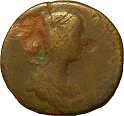Numismática Antigua
 La línea de investigación principal que he desarrollado entre 2003 y 2011 se centra en el estudio y clasificación del material numismático, enfocado éste al análisis de la circulación monetaria a nivel regional, en primer lugar, y nacional, posteriormente. Concretamente, el periodo de estudio al que se han ido encaminando mis investigaciones es el Altoimperio y, en concreto, siglo II d.C., versando mi tesis doctoral sobre este periodo cronológico concreto (La Circulación Monetaria en Hispania durante el siglo II d.C.).
La línea de investigación principal que he desarrollado entre 2003 y 2011 se centra en el estudio y clasificación del material numismático, enfocado éste al análisis de la circulación monetaria a nivel regional, en primer lugar, y nacional, posteriormente. Concretamente, el periodo de estudio al que se han ido encaminando mis investigaciones es el Altoimperio y, en concreto, siglo II d.C., versando mi tesis doctoral sobre este periodo cronológico concreto (La Circulación Monetaria en Hispania durante el siglo II d.C.).
A partir de los datos que la moneda aporta, especialmente si ha sido hallada en contextos arqueológicos claros, se puede extraer múltiple información relacionada con el aprovisionamiento, uso y dispersión de la moneda, además de su perduración en el registro arqueológico.
Debido a esta especialización, han sido realizados desde entonces diversos trabajos de catalogación, tanto de los fondos numismáticos de diferentes museos de la región de Murcia (entre ellos el Museo Arqueológico Municipal de Cartagena) como de los yacimientos regionales donde han aparecido monedas. Estos trabajos de catalogación son la base para el desarrollo de otros de carácter interpretativo acerca de los múltiples aspectos que nos puede aportar el análisis de la circulación de monetaria, siendo considerada la moneda como una fuente material más para la reconstrucción histórica.
Ancient Numismatics
We find very interesting the study of the coin used long time before being minted, the duration of a coin in circulation, and the relation of these aspects with the economic cycle in Antiquity.
The project “Coins and Archaeology. The life of the coins through the archaeological register and its economical, commercial, and social perspectives” has great importance now in the new tendency of numismatic research. How long was the coin on circulation? Were there any moments in which the coin was substituted easier and more frequently? Where and when was the coin introduced quicker and stronger? The possibilities open in this study about the adaptation process of the use of the coin in the Iberian Peninsula are abundant.
After the PhD: Coin Circulation in 2nd century AD in Hispania, it is proposed a more theoretical work, without leaving the field-research, but trying to study in depth the historical possibilities of the study of coins within its archaeological context.
Alte Numismatik
Mein Forschungsfokus, den ich seit 2003 an der Universität Murcia verfolge, konzentriert sich auf die Untersuchung des Geldumlaufs und dessen Charakteristika (Versorgung, Streuung und Entwicklung der Münzen und Münzwerte, und ihr Stellenwert in späteren Epochen).
Um diese Themen zu adressieren, insbesondere die Versorgung und die Streuung der Münzen, ist es sehr wichtig zu verstehen, welche Rolle die römischen Wege, Römerstraβen und viae spielen. Hier muss ebenfalls beachtet werden, wie sich der römische Einfluss und die Romanisierung über die Pyrenäenhalbinsel verbreiteten.
Das hiesige Projekt sucht Antwort auf verschiedene Frage, die im Rahmen meiner letzten Forschungsarbeit aufkamen: welcher Natur war Beziehung zwischen die Fundmünzen und der Lage der Römerstraβen?, Welche Beziehung bestand zwischen der Versorgung der Münzen und Bauen, Reparatur, und Geldanlagen der Römerstraβen?
Ich bin überzeugt, dass die Weiteruntersuchung dieses Themas wichtige Ergebnisse über die Streunng und Verbreitung der Münzen in Hispania liefern wird.
- numismatica_antigua.txt
- Última modificación: 2018/01/21 19:27
- (editor externo)